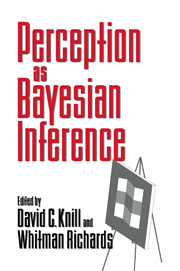Book contents
- Frontmatter
- Contents
- List of contributors
- Preface
- 0 Introduction
- Part one Bayesian frameworks
- Commentaries
- Part two Implications and applications
- 6 Implications of a Bayesian formulation of visual information for processing for psychophysics
- 7 Shape from texture: Ideal observers and human psychophysics
- 8 A computational theory for binocular stereopsis
- 9 The generic viewpoint assumption in a Bayesian framework
- 10 Experiencing and perceiving visual surfaces
- 11 The perception of shading and reflectance
- 12 Banishing the homunculus
- Commentaries
- Author index
- Subject index
11 - The perception of shading and reflectance
Published online by Cambridge University Press: 05 March 2012
- Frontmatter
- Contents
- List of contributors
- Preface
- 0 Introduction
- Part one Bayesian frameworks
- Commentaries
- Part two Implications and applications
- 6 Implications of a Bayesian formulation of visual information for processing for psychophysics
- 7 Shape from texture: Ideal observers and human psychophysics
- 8 A computational theory for binocular stereopsis
- 9 The generic viewpoint assumption in a Bayesian framework
- 10 Experiencing and perceiving visual surfaces
- 11 The perception of shading and reflectance
- 12 Banishing the homunculus
- Commentaries
- Author index
- Subject index
Summary
Introduction
The luminance of a surface results from the combined effect of its reflectance (albedo) and its conditions of illumination. Luminance can be directly observed, but reflectance and illumination can only be derived by perceptual processes. Human observers are good at judging an object's reflectance in spite of large changes in illumination; this skill is known as “lightness constancy”.
Most research on lightness constancy has used stimuli consisting of grey patches on a single flat plane. The models are typically based on the assumption that slow variations in luminance are due to illumination gradients, while sharp changes in luminance are due to reflectance edges. The retinex models for use with “Mondrian” stimuli are good examples (Horn, 1974; Land & McCann, 1971). But in three dimensional scenes, sharp luminance changes can arise from either reflectance or from illumination, as illustrated in Figure 11.1. The edge marked (1) is due to a reflectance change, such as might result from a different shade of paint. The edge marked (2) results from a change in surface normal which leads to a change in the angle of incidence of the light – an effect that we may simply refer to as “shading.” As Gilchrist and his colleagues have emphasized (Gilchrist et al., 1983), three-dimensional scenes introduce large and important effects that are completely missed in the traditional approach to lightness perception.
Intrinsic image analysis
Using the terminology of Barrow & Tenenbaum (1978) we may cast the perceptual task as a problem of computing intrinsic images – images that represent the underlying physical properties of a scene.
Information
- Type
- Chapter
- Information
- Perception as Bayesian Inference , pp. 409 - 424Publisher: Cambridge University PressPrint publication year: 1996
Accessibility standard: Unknown
Why this information is here
This section outlines the accessibility features of this content - including support for screen readers, full keyboard navigation and high-contrast display options. This may not be relevant for you.Accessibility Information
- 100
- Cited by
